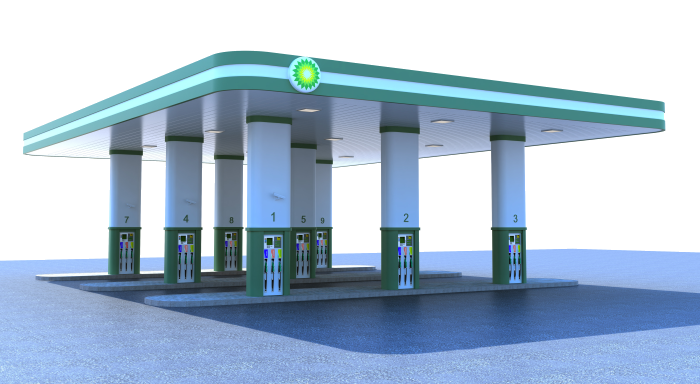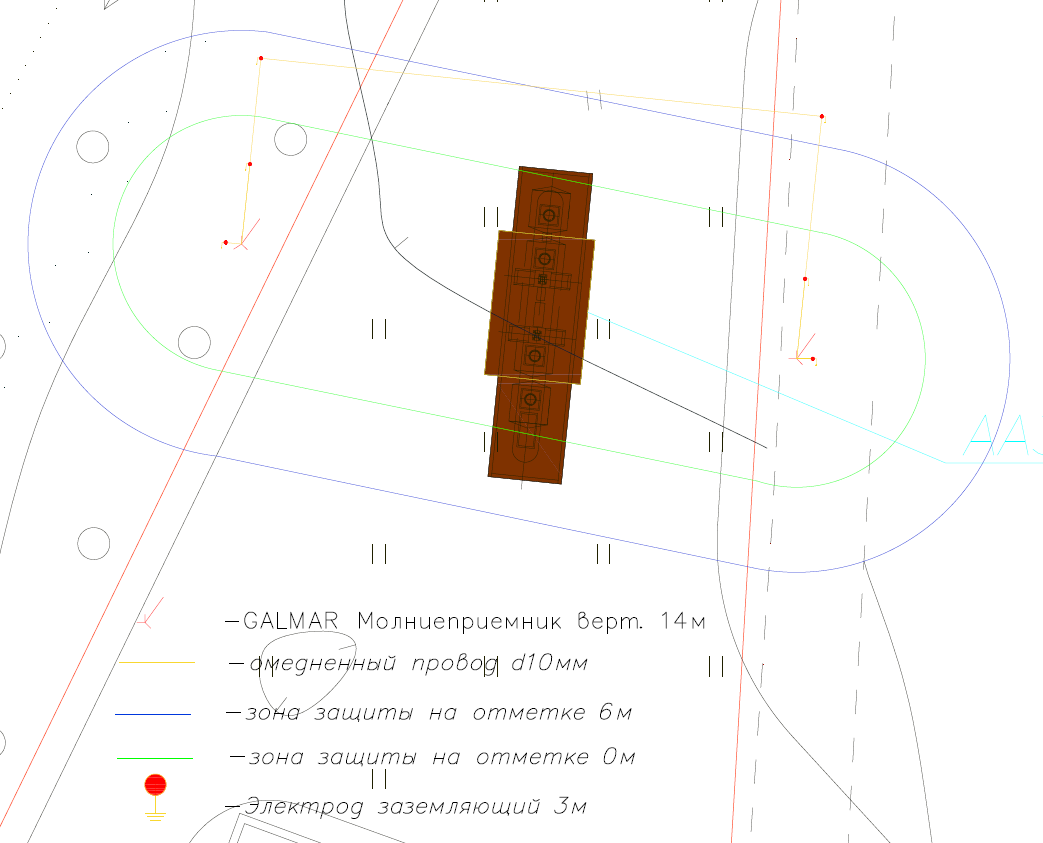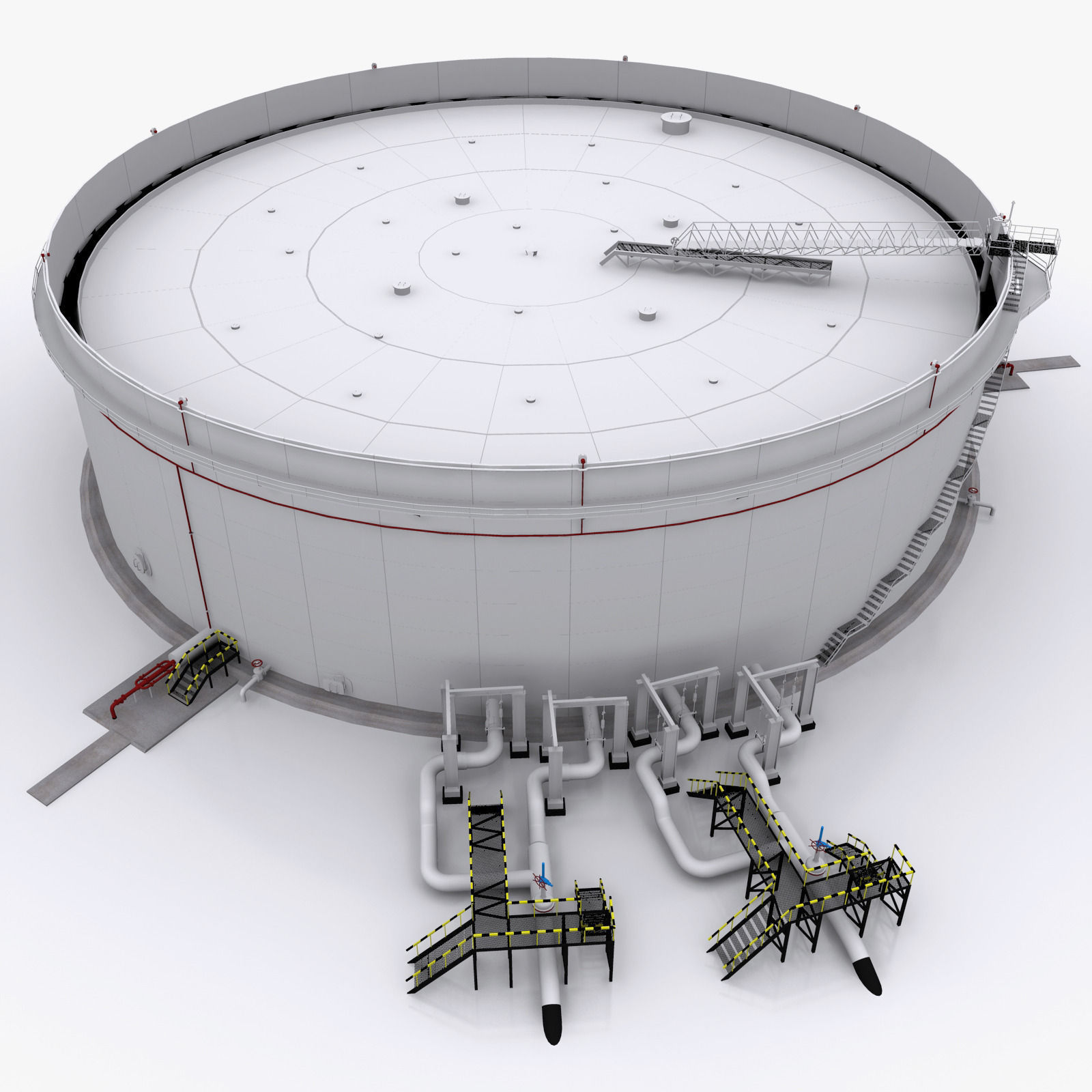
The need for lightning protection and grounding of petrol stations, is mainly conditioned by the affiliation of such structures to explosive and flammable objects. Himan factor, unfavorable weather conditions or short-circuit of electrical equipment, can be the reaosn for a fire at a gas station, unfavorable weather conditions or short-circuit of electrical equipment. As a result of a lightning strike, there can appear fire or explosion at the gas station itself, and the fire will spread to the surrounding area.
According to the normative and technical documents: EIC "Electrical Installations Code. 7th Edition" (hereinafter -EIC)" Instructions for lightning protection of buildings and industrial communications" (IS 153-34.21.122-2003) and" Instructions for lightning protection of buildings and structures" (AD 34.21.122-87) gas stations refer to the objects that could be dangerous for the environment and always require installation of lightning protection.
Solutions on grounding and lightning protection
External lightning protection for a gas station
The current regulatory framework in the field of lightning protection and grounding is given in the Appendix (see below). Based on these documents, let's define what are the requirements for lightning protection systems of a gas station. According to the class of risk from direct lightning strikes (DLS), gas stations refer to the specific objects that represent danger to the environment. Acceptable level of protection against DLS for the given class is in the range from 0.9 to 0.999. It is determined at the design stage and is consistent with the public oversight authorities. If desired, a gas station owner can foresee the level of reliability higher than the maximum permissible in the project. For this class of objects the security level should be 0.99.
According to the IS 153-34.21.122-2003, lightning rod, down conductor and grounding must comply with the requirementd to the material and cross-section:
|
Material |
Cross-section, mm2 |
||
|
lightning rod |
down conductor |
ground electrode |
|
|
Steel |
50 |
50 |
80 |
|
Aluminum |
70 |
25 |
Not applicable |
|
Copper |
35 |
16 |
50 |
Table "Material and minimum cross-sections of elements of external lightning protection"
Lightning rods are installed on the protected building or separately - on the ground. Lightning protecton of a gas station is carried out by freestanding lightning rods. Free standing lightning rods can be carried out as a mast or wires stretched over the perimeter of the protected gas station, lightning protection mesh of conductors or their combinations stretched under the roof.
According to AD 34.21.122-87 all buildings and structures of petrol stations must be protected from direct lightning strikes and of its secondary effects, such as high intensity electromagnetic field generated at the moment of a lightning strike, static electricity and move of high electric potentials on metallic structures of the building, piping, air lines or communication lines.
Lightning protection of gas pumps, containers for storing fuel, ground tanks must be performed by free standing lightning rods or with the use of lightnign rods, installed on the roof of a petrol station in the form of mesh conductors or masts.
A down conductor is conducted to each support of a lightning rod, if it is designed in the form of a standing mast or cable supports; and at least two down conductors for a structure, if a lightning rod is made in the form of a mesh of down conductors.
Down conductors are placed around the perimeter of a gas station in parallel vertical lines with a minimum distance between them of 10 m and are connected by horizontal bundles near the ground with the distance of 20 m over the entire height of the building. Down conductors are fixed either to the wall of the object to be protected, or are laid directly in it. If the wall material is flammable, the distance between it and the down conductor should be at least 10 cm. Down conductors must be laid along the shortest path, without forming loops and as far away as possible from window and door openings.
According to IS 153-34.21.122-2003, p. 3.2.2.5. any metal structures of a gas station can perform as natural down conductors, in case if they correspond to the requirements imposed to a down conductor, and their thickness exceeds 0.5 mm.
At the gas stations, down conductors are connected with lightning rod and grounding by means of clamps or bolts. To be able to connect measuring equipment, there must be bolt connection on down conductors. All parts of down conductors which are above the ground, except for the contact surfaces are painted in black.
In almost all cases, ground electrodes are united with the ground electrodes of electrical and communication systems. Free standing lightning rods are an exception, for which own grounding contours are mounted. Therefore, the requirements to the ground electrode will be studied in the next section of this article - "Grounding of a gas station" (see below.).
Internal lightning protection for a gas station
The danger of secondary effects lies in the generation of high voltage on the metal objects and possible arcing. It is particularly dangerous at the gas stations because it can lead to an explosion of tanks, fuel tanks or fire on the gas station itself. Therefore, protection against secondary effects of lightning - is one of the most important issues of a gas station protection, which should be observed at the design stage and includes grounding of all electrical equipment, electronic computers, fuel tanks, petrol stations, oil and gas pipelines. All works on grounding must also be carried out by the licensed companies.
Internal lightning protection of a gas station includes protection of expensive electronic equipment and electric appliances from high voltage due to a lightning strike and its current spreading over unprotected communication lines.
Protection measures are:
- shielding;
- installation of surge protection devices (SPD);
- equipment grounding.
SPD is a device designed to prevent excess voltage getting on the device. In order to determine in what places it is necessary to install SPD, in accordance with the IS 153-34.21.122-2003 p. 4.2, the protected object, in our case a gas station, is conventionally divided into protection zones - 0, 0E, 1, and others: Zone 0 - an area in which each object is subjected to a direct lightning strike (DLS) and the electromagnetic field in this zone is peak. Zone 0E - objects in this area are not subject to DLS, electromagnetic field remains high, but less than in zone 0. Zone 1 - objects are protected from DLS and the electromagnetic field is weakened. Other areas - are divided, if it is necessary to further weaken the electromagnetic field and to reduce the lightning current.
The IS 153-34.21.122-2003 states that all power and communication lines must be terminatied to the building by one bus, and their SPDs must be as close as possible to each other and must provide the lightning current drainage to the grounding system at the boundary of zones 0 and 1. Screening should be implemented at the intersection of two zones. Metal construction of the building, reinforcement of foundation, walls, ceilings and other metal connections can act as a shield. One should also take care of the protection of equipment, which is located outside the building. This may be video cameras, antennas, sensors (temperature, motion, light) etc. In this case, it is reasonable to use shielded connecting cables, run them in metal or plastic ductings. If it is impossible to run a cable in a ducting, use natural shields, such as metal pipes, ladders and others. Protection of communication lines involves choosing of shielded metal cables, and in those places, where possible, use fiber optic cable without metal elements. This cable is the perfect solution, as it is fully protected from the electromagnetic field effects.
Grounding for a gas station
A modern gas station is equipped with a huge number of electronic computers and electric equipment - starting from the operating terminal of a gas station, refrigerators, ovens, microwave ovens, coffee machines and finishing with promotion billboards and gasoline columns with electronic boards to display the prices of the poured volume of fuel. All this equipment needs to be protected against short circuit and voltage breakdown on the equipment body frame. Grounding helps to solve this problem. In a general case, grounding consists of grounding electrodes connected with the each other and with the secured object by copper or steel grounding conductors. On the site ZANDZ.com you can read more about grounding types and ways of their installation.
According to the documents IS 153-34.21.122-2003, p. 3.2.3.2. and AD 153-39.2-080-01, p 9.29, the grounding system should be executed in the form of a ground electrode paved along the perimeter of the building or object at the depth of 0.5-0.7 m and at the distance of not less than 1 m from the foundation. The electrode is laid at a certain depth, considering soil resistivity and its variations in different seasons. Resistance of the grounding device should not exceed 10 ohms.
Example of calculation of grounding and lightning protection for a gas station
An object: gas station;
length: 24 m;
width: 8 m;
Height: 4.3 m;
gasoline storage is directly under the filling stations;
soil: loam, soil resistivity: 100 ohm*m.
Task: perform lightning protection and grounding system for the object.
Solution: An object refers to a special class in terms of lightning protection, in accordance with the IS and to the 2 category according to the EIC-7.
According to the EIC-7, p. 1.7.103. The total resistance of spreading of ground electrodes (including natural) of all repeated grounding of the PEN conductor of every overhead line at any time of the year should not exceed 10 ohms at the line voltage of 380 V of a three-phase power supply or 220 V of a single-phase power source.
According to AD 153-39.2-080-01 p.9.29. There should be a common grounding contour at a gas station for electrical equipment, protection from static electricity, direct strikes and and secondary effects of lightning. Spreading resistance of ground electrodes' current should not exceed 10 ohms.
Gas station lightning protection is carried out by means of lightning rods. Lightning protection system consists of an air terminal, directly percieving lightning strikes, and a ground electrode.
Set of measures:
- installation of two separate air terminals masts 17 m high;
- according to AD 34 p 2.2 (d) a lightning rod is grounded by 3 electrodes;
- installation of the grounding device, which consists of five vertical electrodes D = 14 mm, 3 m long, united by the horizontal electrode (copper-bonded wire 10 mm). The distance from the electrode to air terminal mast 1 m, the distance between the electrodes is 5 m, deepening of 0.5 - 0.7 meters.
Calculation of resistance of a grounding device:
Resistance of a vertical electrode:

where ρeq - equivalent soil resistivity,
ohm · m;
L - length of the vertical electrode, m;
d - vertical electrode diameter, m;
T- deepening - distance from the ground surface to the ground electrode, m;

where t - deepening of the electrode top, m
Resistance of a horizontal electrode:

where D - horizontal electrode diameter, m;
t - laying depth of the horizontal mesh, m;
Lгор - horizontal electrode length, m.
Impedance of the grounding device:

where N - number of kits;
Kисп - utilization ratio;




The design resistance of a grounding device is 2,6 Ohms, which is less than the required impedance of 10 Ohm.
Calculation of protection zone parameters for a double lightning rod:
The minimum height of the zone between the lightning rods:

The width of the horizontal cross-section in the center between the lightning rods at the height of hx:

Source data: h = 17 m
L = 35 m
h0 = 0.8h = 13,6 m
r0 = 0.8h = 13.6 m
Lmax = 4.75h = 80,75 m
Lc = 2.25h = 38,25 m

for hx = 6 m:

Lmax; Lc; h0; r0 - tabulated values (IS 153-24 p 3.5-3.6)
Protection zones are calculated according to IS p. 3.3.2.2 and are presented graphically in Fig. 1

Fig.1. Lightning protection zones and equipment layout for grounding
Молниеприёмник вертикальный – vertical lightning rod
Омедненный провод – copper bonded wire
Зона защиты на отметке – protection zone at the mark of 6 m
Электрод заземляющий – grounding electrode
List of equipment and necessary materials:
| Item No. | Fig | Product item | Product | Q-ty |
| 1 |  |
GL-21113 | GALMAR Lightning rod vertical high (air terminal mast) (17 meters) | 2 |
| 2 |  |
GL-11150-50 | GALMAR Copper-bonded wire (D 10 mm / S 80 mm²; coil 50 meters) | 2 |
| 3 |  |
ZZ-001-065 | ZANDZ Copper-bonded threaded grounding pin (D14; 1,5 m) | 12 |
| 4 |  |
ZZ-002-061 | ZANDZ Threaded coupler | 7 |
| 5 |  |
ZZ-003-061 | ZANDZ Starting tip | 6 |
| 6 |  |
ZZ-004-060 | ZANDZ Driving head for a breaker hammer | 3 |
| 7 |  |
ZZ-006-000 | ZANDZ Conductive grease | 1 |
| 8 |  |
ZZ-008-000 | ZANDZ Cap for a breaker hammer (SDS max) | 1 |
| 9 |  |
ZZ-005-064 | ZANDZ Clamp for connecting conductor (up to 40 mm) (до 40 мм) |
7 |
| 10 |  |
ZZ-007-030 | ZANDZ Water-proof tape | 2 |
Conclusion
Having dealt with the issues of building lightning protection and grounding at the gas stations and the requirements for them, it is also worth noting the importance of maintaining these systems in good working condition. According to the labour protection rules Р М-021-2002 p.5.3.14, routine and measuring operations must be annually carried out in summer. They include checking of the status of all down conductors, their connections, measuring of resistance of ground electrodes. If the resistance of the grounding contour is 20% greater than the maximum allowable, it is necessary to install additional electrodes. Replacement of down conductors and ground electrodes is performed in case if their cross-sectional area decreased by 25%.
Proper planning of a lightning protection and grounding system of a gas station, as well as its maintenance in working condition, will allow to protect humans, animals and the environment from negative effects of a lightning strike.
Appendix
Regulatory documents in the field of lightning protection and grounding:
- Electrical installations code. 7th Edition"
- "Instructions for lightning protection of buildings, structures and industrial communications" (IS 153-34.21.122-2003)
- "Instructions for lightning protection of buildings and structures" (AD 34.21.122-87)
- Authorizing document AD 153-39.2-080-01 "Rules of technical operation of gas stations"
- Interindustry labor safety rules during operation of fuel storages, stationary and mobile gas stations (LPR P M-021-2002)
See also:
- Lightning protection of oil and gas facilities (article)
- Lightning protection and grounding. Solutions for large objects
- SPD selection principles on the example Leutron devices (article)
- Design of grounding and lightning protection
- Calculaton of grounding
Related Articles:

 Protection of Fuel and Lubricant Materials (FLM) Storages with Floating Roofs Against the Static Electricity
Protection of Fuel and Lubricant Materials (FLM) Storages with Floating Roofs Against the Static Electricity
 Five Most Dangerous Effects of Lightning
Five Most Dangerous Effects of Lightning


